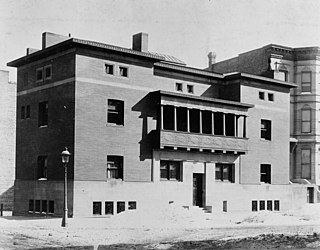
The James Charnley Residence, also known as the Charnley-Persky House, is a historic house museum at 1365 North Astor Street in the Gold Coast neighborhood of Chicago, Illinois. Built in 1892, it is one of the few surviving residential works of Louis Sullivan, and features major contributions by Frank Lloyd Wright, who was then working as a draftsman in Sullivan's office. The house is operated as a museum and organization headquarters by The Society of Architectural Historians (SAH). The house was designated a National Historic Landmark in 1998, and is listed on the National Register of Historic Places.

The James D. and Alice Butler House, commonly known as the Butler House, is a historic home in Deerfield Beach, Florida. It is located at 380 East Hillsboro Boulevard. On July 28, 1995, it was added to the U.S. National Register of Historic Places.
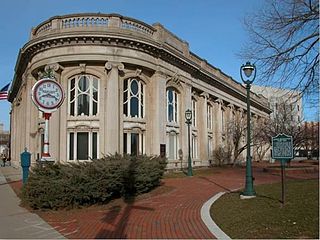
The Milwaukee County Historical Society, also known as MCHS, is a local historical society in Milwaukee County, Wisconsin. Founded in 1935, the organization was formed to preserve, collect, recognize, and make available materials related to Milwaukee County history. It is located in downtown Milwaukee in the former Second Ward Savings Bank building.
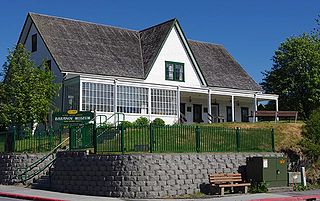
The Baranov Museum is a history museum at 101 East Marine Way in Kodiak, Alaska. It is located in a National Historic Landmark building known as the Russian-American Magazin [sic] and the Erskine House, which also houses the office of the Kodiak Historical Society. Built c. 1810, the building is the oldest of four surviving building constructed by the Russians when Alaska was a Russian territory. The museum's collections and exhibits are focused on the history of the Kodiak Archipelago and the Aleutian Islands, with particular focus on the Russian and early American periods. The museum's current director is Sarah Harrington.
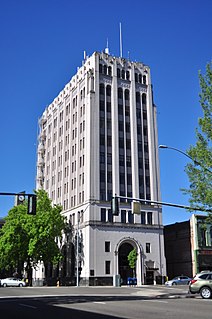
The Capitol Center is a high-rise office building in downtown Salem, Oregon, United States. Finished in 1927, it was originally known as the First National Bank Building and owned by Salem businessman Thomas A. Livesley. The eleven story building was designed by architect Leigh L. Dougan and is the tallest office building in Salem. Located at State and Liberty streets it is part of Salem's downtown historic district and was added to the National Register of Historic Places in 1986 as the Old First National Bank Building.

The Enoch Kelsey House is a historic house museum at 1702 Main Street in Newington, Connecticut. Built about 1799, it is a well-preserved example Federal period residential architecture. Originally located near the New Britain line, it was moved to its present site in 1979 to save it from demolition. It was listed on the National Register of Historic Places in 1982.

The Sewall-Scripture House, is a historic house museum at 40 King Street in Rockport, Massachusetts that is owned by the Sandy Bay Historical Society. The Sewall Scripture Museum features antiques, period artifacts and items of local history. The Federal style building, the only house in Rockport built out of native granite, was added to the National Register of Historic Places in 1982.

The Federal Reserve Bank of Chicago Detroit Branch Building is a bank building located at 160 West Fort Street in downtown Detroit, Michigan. It was listed on the National Register of Historic Places in 2008.
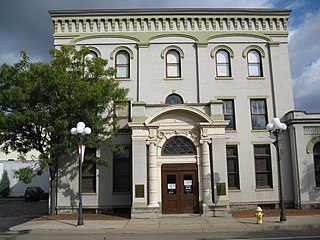
The Chemung Canal Bank Building is located at 415 East Water Street in Elmira, Chemung County, New York, United States. It is thought to be the oldest commercial building in Elmira. The Chemung Canal opened in 1832 and construction on the bank building began the same year. In 1833 the bank moved into the new building and the Chemung Canal Trust Company was chartered to deposit cash and supply capitol and credit. The building continued to house the bank for seventy-six years. For the following fifty-six years it was home to various local law offices. From 1976 forward, it has been owned by the Chemung County Historical Society. The building is significant for its period architecture and its place in the history of the area. It was named to the National Register of Historic Places in 1978.
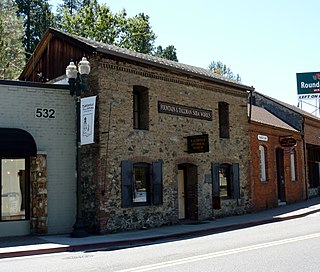
The Fountain-Tallman Soda Works is a historic building in Placerville, El Dorado County, California. It currently houses the Fountain & Tallman Museum, which is owned and operated by the El Dorado County Historical Society. The rustic vernacular Victorian stone and brick building, of the Gold Country, was placed on the National Register of Historic Places on September 13, 1984.

Albion State Bank was an historic structure in Albion, Oklahoma. Albion, located amidst the rugged and rural but verdant Kiamichi Mountains, in northeastern Pushmataha County, Oklahoma.

Virginia House is a manor house on a hillside overlooking the James River in the Windsor Farms neighborhood of Richmond, Virginia, United States.

Davenport Bank and Trust, also known as Davenport Bank Apartments, is a mixed-use facility located in Downtown Davenport, Iowa, United States. It was listed on the National Register of Historic Places in 1983 as American Commercial and Savings Bank. In 2016 the National Register approved a boundary increase with the Davenport Bank and Trust name. Davenport Bank and Trust was at one time Iowa's largest bank, and the building has dominated the city's skyline since it was built. The tallest building in the Quad Cities, it houses commercial, office and residential space.

The Eagle Harbor Schoolhouse is a school located at the corner of Third and Center Streets in Eagle Harbor, Michigan, United States. It is significant as the location where Justus H. Rathbone was first inspired to write the ritual which was the basis of the Order of the Knights of Pythias. The schoolhouse was designated a Michigan State Historic Site in 1971 and listed on the National Register of Historic Places in 1972. It is also known as the Pythian Shrine and as the Rathbone School.

The Clutts House is a historic residence in the city of Wellston in Jackson County, Ohio, United States. Built in 1902, it was constructed as the home of Joseph Clutts, a leading member of Wellston society and industry.
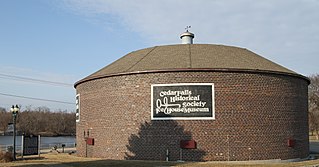
The Cedar Falls Ice House is an historic building located in Cedar Falls, Iowa, United States. It was built in 1921 and has been listed on the National Register of Historic Places since 1977. The building currently serves as the Ice House Museum.

Alfred Giles (1853–1920) was a British architect who emigrated to Texas in 1875, at the age of 22. Many of the private homes and public buildings designed by Giles are on the National Register of Historic Places and have been designated Recorded Texas Historic Landmarks. A number of his designs can be found in San Antonio and in Kendall County, Texas. He is known for his numerous designs of county courthouses, of banks and other commercial buildings, and homes he designed in central Texas and Mexico. Giles is credited with "a profound influence on architecture in San Antonio."
The Kelsey Museum of Archaeology is a museum of archaeology located on the University of Michigan central campus in Ann Arbor, Michigan, in the United States. The museum is a unit of the University of Michigan's College of Literature, Science, and the Arts. It has a collection of more than 100,000 ancient and medieval artifacts from the civilizations of the Mediterranean and the Near East. In addition to displaying its permanent and special exhibitions, the museum sponsors research and fieldwork and conducts educational programs for the public and for schoolchildren. The museum also houses the University of Michigan Interdepartmental Program in Classical Art and Archaeology.

The Foreman–Roberts House, formerly the James D. Roberts House and now also known as the Foreman–Roberts House Museum, is a historic house and museum located at 1217 N. Carson St. in Carson City, Nevada. The house was built in 1859 and was moved to the present location in 1873. Known also as the Thurman Roberts House for the last member of the Roberts family, it is listed on the National Register of Historic Places. It is the headquarters of the Carson City Historical Society and is open to the public by appointment and for special events.

Marble Rock Bank, also known as the Marble Rock Historical Society Building, is a historic building located in Marble Rock, Iowa, United States. New York native J.B. Shepardson settled in Marble Rock in 1864. He was involved in a number of ventures including running a store, a hotel, and land speculation. He and his brother S.E. Shepardson opened the Marble Rock Bank in 1873, and they had this building constructed in 1885. It is a single-story structure that features a stone facade, nine corbels that support a plain cornice, and a simple stone plaque that identified the building as a bank. The building survived two fires that destroyed much of the town in 1899, making this the oldest commercial building in town. Banking operations moved from here in 1927, and the bank itself closed in 1932. The Marble Rock Historical Society, established in 1972, bought the building in 1974 for use as a museum. They have subsequently acquired other buildings that have been added to the museum complex. The former bank building was listed on the National Register of Historic Places in 1982.
























